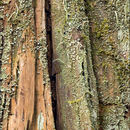en
names in breadcrumbs


SQUAMULES: to 6 mm, weakly lobed, not sorediate
PODETIA: 10-25 mm tall, tapered, covered with fine soredia except at base
APOTHECIA: none
CHEMISTRY: medulla K+ faintly brownish, PD+ orange-red, UV- (fumarprotocetraric acid)
Common Name: Common Powderhorn
Pointy-stemmed cladonia with large squamules. Stems sorediate all over.
Several similar species include:
C. cornuta brownish, squamules less than 3 mm, corticate in patches below C. ochrochlora greenish, squamules over 3 mm, largest stems over 2 mm wide, corticate in bottom third to half C. coniocraea grayish, squamules over 3 mm, largest stems less than 2 mm wide, corticate only at very base C. subulata squamules disappearing, sorediate all over, on soil instead of wood
Cladonia coniocraea, commonly known as the common powderhorn or the powderhorn cup lichen,[3] is a species of fruticose, cup lichen in the family Cladoniaceae. It was first described by Heinrich Gustav Flörke in 1821 under the name Cenomyce coniocraea,[1][4] until Kurt Polycarp Joachim Sprengel reclassified it under the genus Cladonia in 1827.[1][2]
As of July 2021, its conservation status has not been estimated by the IUCN. In Iceland, its conservation status is denoted as data deficient (DD).[5]
Cladonia coniocraea, commonly known as the common powderhorn or the powderhorn cup lichen, is a species of fruticose, cup lichen in the family Cladoniaceae. It was first described by Heinrich Gustav Flörke in 1821 under the name Cenomyce coniocraea, until Kurt Polycarp Joachim Sprengel reclassified it under the genus Cladonia in 1827.
As of July 2021, its conservation status has not been estimated by the IUCN. In Iceland, its conservation status is denoted as data deficient (DD).